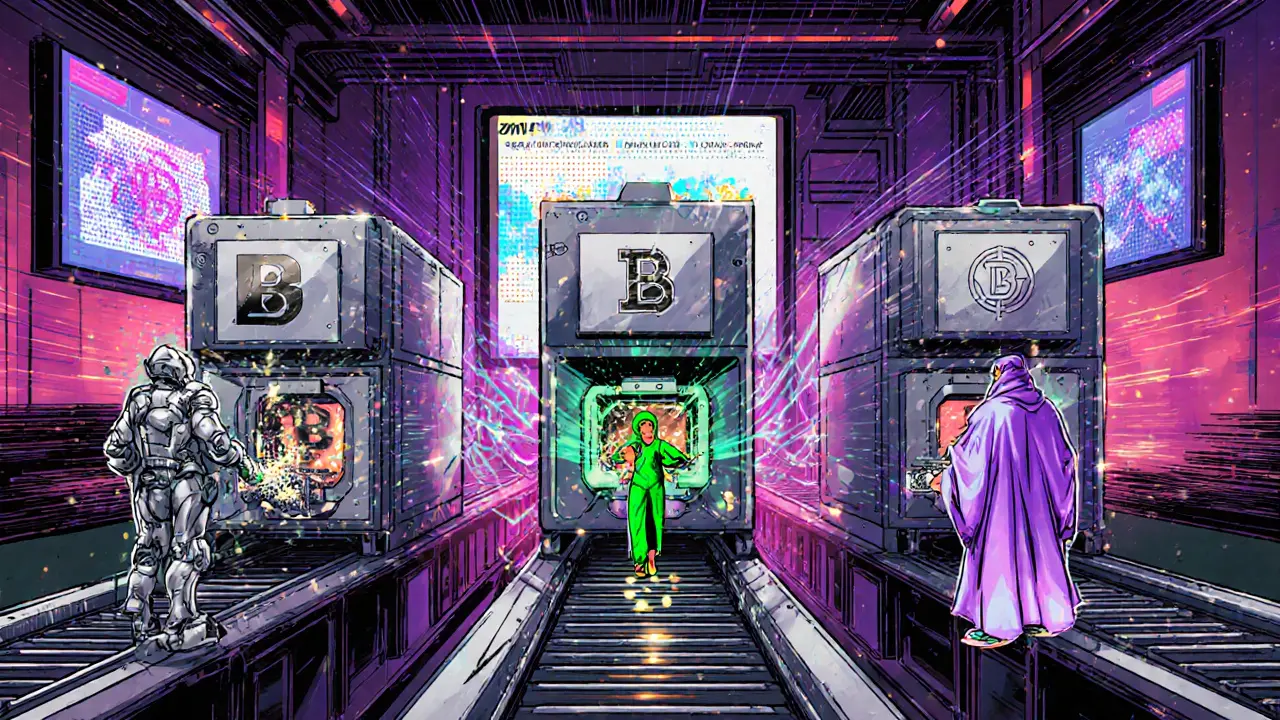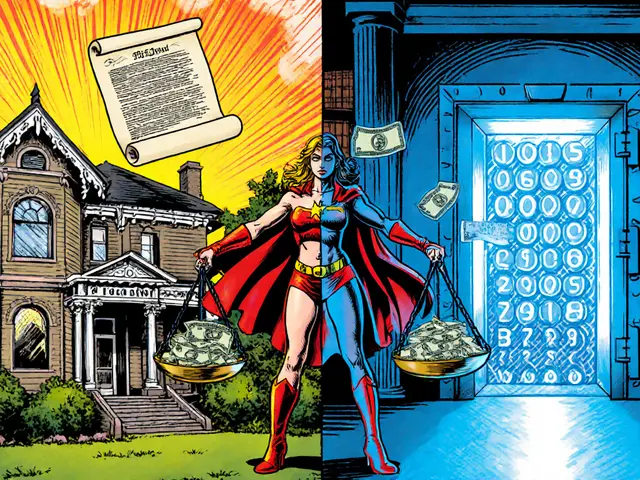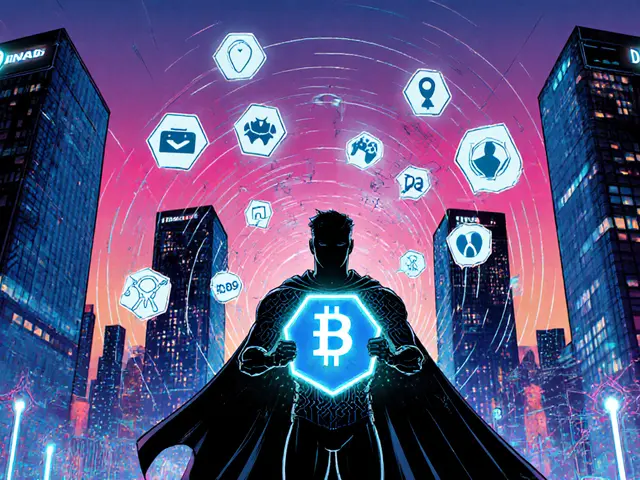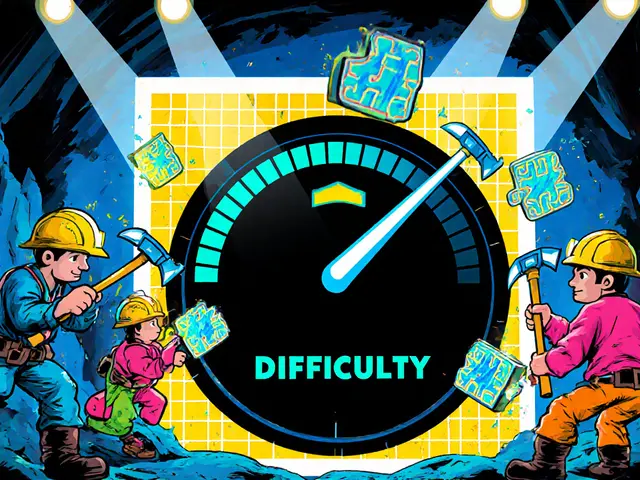DApp Development Trend Analyzer
This tool helps analyze the key trends shaping DApp development in 2025. Select a trend below to see how it impacts DApp architecture and development practices.
Cross-Chain Interoperability
Protocols like Hyperlane and LayerZero enable seamless communication between different blockchain networks.
EssentialModular Blockchains
Separation of consensus, execution, and data availability layers improves scalability and reduces costs.
RevolutionarySecurity & Privacy
Zero-knowledge proofs and multi-signature wallets enhance privacy and security for enterprise adoption.
CriticalSelect a Trend
Impact Analysis
Select a trend and click "Analyze Impact" to see detailed analysis.
When people talk about the next wave of internet software, decentralized applications software that runs on blockchain networks instead of central servers, offering censorship‑resistance and trustless interaction dominate the conversation. By 2025 the ecosystem is moving past early hype and into a phase where real‑world problems-finance, health, logistics, gaming-are being solved with truly distributed code.
Quick Take
- Modular blockchains (e.g., Celestia, Polygon 2.0) are decoupling consensus, execution and data availability.
- Cross‑chain bridges and interoperability layers let a single DApp talk to dozens of networks.
- Zero‑knowledge proofs and multi‑signature wallets raise privacy and security to enterprise levels.
- IoT integration brings real‑time sensor data onto Web3, enabling autonomous supply‑chain and smart‑home services.
- DeFi, NFTs, and DAOs converge into “MetaFi” platforms that power gaming, music, and digital art economies.
Key Trends Shaping DApps in 2025
Five technical currents are pulling the DApp landscape forward:
- Smart‑contract evolution - multi‑signature auth, built‑in upgradability, and bug‑bounty incentives are now standard.
- Scalable networks - rollups, zk‑EVMs, and modular data‑availability layers cut fees while keeping security.
- IoT‑Web3 fusion - sensors publish immutable logs directly to blockchain, enabling trust‑free automation.
- Enhanced security protocols - zero‑knowledge proofs (ZKPs) hide personal data yet still prove compliance.
- Cross‑chain interoperability - protocols like Hyperlane and LayerZero let assets and messages move without custodial bridges.
Analysts now forecast the underlying blockchain market to hit $1trillion by 2032, so each trend is backed by deep capital.
Modular Blockchain Architecture: Why It Matters
Traditional “all‑in‑one” blockchains bundle consensus, execution, and data availability. Modular blockchains networks that separate these core functions into interchangeable layers give developers the freedom to pick the best‑fit service for each use case.
Celestia’s launch in 2023 proved that a dedicated data‑availability layer can serve dozens of execution chains, dramatically lowering the cost of launching a new DApp. Polygon 2.0 built on the same idea, adding a zk‑rollup for privacy‑first transactions. EigenLayer lets Ethereum stakers re‑stake their ETH to secure these modular services, creating a shared security pool that reduces duplication.
| Attribute | Modular | Monolithic |
|---|---|---|
| Consensus Layer | Dedicated (e.g., Celestia) | Integrated |
| Execution Layer | Pluggable (e.g., zk‑rollup, Optimistic) | Fixed |
| Data Availability | Separate service, high throughput | Limited by block size |
| Scalability | Horizontal scaling across layers | Vertical scaling only |
| Cost | Pay‑per‑service, often lower | Higher due to bundled overhead |
| Examples | Celestia, Polygon 2.0, EigenLayer | Ethereum L1, Binance Smart Chain |
For a startup, modularity means you can launch a fast, privacy‑focused DApp without building a whole new L1. The shared security from staking also gives investors confidence.
Cross‑Chain Interoperability: One DApp, Many Networks
Early DApps were locked to a single chain-Uniswap on Ethereum, PancakeSwap on BSC. Today cross‑chain interoperability technology that lets smart contracts communicate across different blockchains is the norm.
Protocols such as Hyperlane, Axelar, and LayerZero provide message‑passing guarantees, while bridges that rely on custodial contracts are being phased out for trust‑less rollups. The result? A DeFi user can provide liquidity on an Ethereum AMM, borrow assets on a Solana market, and settle the loan on a Cosmos‑based chain-all in one transaction.
Interoperability also fuels the rise of MetaFi platforms that blend DeFi, NFTs, and DAOs to create finance for the Metaverse. Game studios can issue in‑game NFTs on one chain and let players trade them on a different marketplace with zero friction.

Security & Privacy Advances: From Theory to Production
Security remains the top concern for developers, especially in regulated sectors like healthcare. Zero‑knowledge proofs (ZKPs) have moved from academic papers to production‑grade SDKs. A hospital DApp can now prove a patient’s age is over 18 without ever exposing the birthdate, satisfying HIPAA‑like rules.
Multi‑signature wallets are standard for DAO treasuries, requiring, say, three out of five signers before funds move. Combined with timelocks, this adds a human‑in‑the‑loop safety net that single‑key wallets lack.
Bug‑bounty platforms, now integrated directly into many blockchain explorers, reward hunters for finding flaws before they can be exploited. This crowdsourced security model has cut major exploits by roughly 30% year‑over‑year according to industry reports.
Real‑World DApp Use Cases in 2025
Finance: DeFi protocols now manage $231billion in assets, with AMMs and liquidity mining driving growth. Stablecoin issuers use modular rollups to keep transaction fees under $0.001, making them viable for everyday payments.
Supply‑Chain & IoT: Logistics firms attach temperature sensors to cargo, publishing immutable readings to a blockchain. If a shipment exceeds a threshold, a smart‑contract automatically releases insurance payouts.
Healthcare: Patient consent DApps store consent hashes on‑chain, while ZKPs verify that a researcher has permission to access anonymized data without revealing identity.
Gaming & Metaverse: Play‑to‑earn titles mint in‑game assets as NFTs on fast zk‑rollups, letting gamers trade items instantly across marketplaces without gas spikes.
Energy: Decentralized grids use token‑based incentives to balance supply and demand, rewarding households that feed excess solar power back into the network.
How to Build a DApp in 2025: A Practical Checklist
- Choose a modular execution layer (e.g., a zk‑rollup) that matches your privacy and speed needs.
- Define the data‑availability service-Celestia for high‑throughput reads, or a bespoke layer if you need custom sharding.
- Write smart contracts in Solidity0.8.x or Move, incorporating multi‑signature checks and upgradeable proxy patterns.
- Integrate a cross‑chain router (LayerZero SDK) if you plan to interact with other networks.
- Implement ZKP verification using libraries like snarkjs for any user‑sensitive logic.
- Set up a bug‑bounty program on platforms such as Immunefi before mainnet launch.
- Deploy via a blockchain‑as‑a‑service (BaaS) provider to speed up onboarding and gain compliance tooling.
Following this checklist cuts development time from months to weeks and gives you a security‑first foundation.
Challenges Ahead and How to Navigate Them
Despite rapid progress, three hurdles remain:
- Regulatory clarity - While 2025 sees clearer DeFi guidelines in the EU and US, jurisdictions differ. Adopt flexible KYC/AML modules that can be toggled on or off.
- User experience - Wallet onboarding still feels arcane. Embedding social‑login‑backed wallet solutions (e.g., WalletConnect v2) can bridge the gap.
- Interoperability standards - Multiple bridge protocols compete, risking fragmentation. Focus on open‑standard solutions like IBC (Inter‑Blockchain Communication) that are gaining ecosystem support.
Staying nimble-by designing modular smart contracts and keeping an eye on emerging standards-will help teams adapt as the landscape settles.
Frequently Asked Questions
What makes a DApp different from a regular web app?
A DApp runs its code on a blockchain instead of a single server, meaning there’s no single point of failure and users keep ownership of their data and assets.
Do I need to learn multiple blockchains to build a DApp?
Not necessarily. Thanks to modular and cross‑chain tools, you can develop on one execution layer and later plug in others without rewriting the whole codebase.
How secure are zero‑knowledge proofs for privacy?
ZKPs have been mathematically proven to reveal no underlying data while still confirming truth. Major platforms (e.g., zkSync, StarkNet) use them for transactions worth billions daily.
Can DApps be regulated like traditional finance services?
Regulators are focusing on the on‑ramps and off‑ramps (wallets, exchanges) rather than the code itself. Using compliance‑ready modules can keep a DApp within legal bounds.
What is the best way to attract developers to my DApp project?
Provide clear documentation, open‑source core contracts, and a bounty program. Communities on GitHub and Discord fuel rapid iteration and trust.




Brooklyn O'Neill
January 8, 2025 AT 02:08Great overview! I love how the post breaks down modular blockchains and cross‑chain tools – it really helps newcomers see where to start. If you're building a DApp, consider leveraging a data‑availability layer like Celestia to keep costs low while still getting strong security. Also, keeping the smart contracts upgradeable from the get‑go can save a lot of hassle later on.
Ciaran Byrne
January 9, 2025 AT 00:21Solid points on interoperability.
Patrick MANCLIÈRE
January 9, 2025 AT 22:35Reading this feels like a whirlwind tour through the frontier of blockchain engineering, and I’m thrilled to see how each piece fits together.
First, the shift to modular architectures untethers consensus from execution, which means developers can cherry‑pick the best environment for their specific workload, whether that’s an optimistic rollup for speed or a zk‑rollup for privacy.
Second, cross‑chain protocols such as Hyperlane and LayerZero are finally delivering the promise of a truly interconnected ecosystem, allowing assets and messages to flow without the old custodial bridge risks.
Third, the maturation of zero‑knowledge proofs is a game‑changer for regulated industries; they can prove compliance without leaking any data, a feature that hospitals and banks have been yearning for.
Fourth, the integration of IoT sensors directly onto blockchains opens up autonomous supply‑chain automation – think temperature‑controlled shipments that trigger insurance payouts automatically.
Fifth, the rise of MetaFi blends DeFi, NFTs, and DAOs, creating new economic models for gaming, music, and digital art that were impossible a few years ago.
From a developer’s standpoint, the new checklist-pick a modular execution layer, select a data‑availability service, write upgradeable contracts, add cross‑chain routing, and embed ZKP verification-really condenses months of research into a few weeks.
Security cannot be an afterthought; bug‑bounty programs on platforms like Immunefi are now standard, reducing exploit risk by roughly a third year over year.
The regulatory landscape is finally catching up, with clearer guidelines in the EU and US, but we still need flexible KYC/AML modules that can be toggled as needed.
User experience remains a hurdle, but wallet‑connect solutions and social‑login‑backed wallets are narrowing the gap between crypto‑savvy users and the mainstream.
Overall, the ecosystem’s momentum suggests that by 2025, DApps will be as commonplace as SaaS platforms today, powered by a stack that emphasizes modularity, security, and seamless interoperability.
Carthach Ó Maonaigh
January 10, 2025 AT 20:48Yo, this stuff sounds fancy but half the time it’s just hype wrapped in buzzwords. Interoperability? Yeah, until the bridge gets ripped apart by a hack and you lose half your portfolio. Modularity looks neat on paper, but the learning curve is insane – you’ll need a PhD just to spin up a simple DApp. And don’t even get me started on ZK‑proofs, they’re like wizardry for the rest of us. Bottom line: spend less time dreaming and more time building something that actually works.
Marie-Pier Horth
January 11, 2025 AT 19:01Ah, the future of DApps – a tapestry woven with the threads of ambition and fleeting dreams. One can almost hear the faint echo of philosophers debating the very nature of decentralization in a digital agora. Yet, as we stand on this precipice, must we not ask whether the ether we chase is not mere illusion, a shimmering mirage over a desert of code? In any case, the article paints a picture as delicate as a sunrise over a blockchain horizon.
Gregg Woodhouse
January 12, 2025 AT 17:15meh looks ok but idk if its worth the hype lol
F Yong
January 13, 2025 AT 15:28Oh sure, zero‑knowledge proofs will magically fix all privacy concerns while governments sit back sipping tea. Meanwhile, the real agenda is hidden behind layers of "security" that only the elite can truly understand. Nice read if you enjoy being fed corporate propaganda.
Sara Jane Breault
January 14, 2025 AT 13:41Nice breakdown! If you’re stuck on a specific layer, just check the docs and ask the community – they’re usually quick to help.
Anurag Sinha
January 15, 2025 AT 11:55Did you notice how every "new" tech is just a rebranded version of the same old control mechanisms? The so‑called "decentralized" platforms are still run by shadowy elites, and the whole IoT‑Web3 hype is a perfect cover for mass surveillance. Wake up, people!
Raj Dixit
January 16, 2025 AT 10:08Look, India is falling behind because we still cling to outdated tech. Everyone should adopt these modern DApp frameworks now or be left in the dust. It’s simple – if you’re not using the latest blockchain stack, you’re basically anti‑progress.
Darrin Budzak
January 17, 2025 AT 08:21Really nice summary. I think the modular approach will make onboarding new devs a lot smoother, especially with the shared security models.
karyn brown
January 18, 2025 AT 06:35Wow, this article is *so* overhyped 😒. I mean, sure, modularity is cool, but the reality is most projects still choke on gas fees and poor UX. 🌚
Megan King
January 19, 2025 AT 04:48Great points! If you need help with setting up a zk‑rollup, just let us know – happy to walk you through the steps.
CJ Williams
January 20, 2025 AT 03:01What a fantastic read! 🌟 The future of DApps looks brighter than ever – modular chains, cross‑chain bridges, and ZK‑proofs will empower creators worldwide. Keep pushing the boundaries! 🚀
mukund gakhreja
January 21, 2025 AT 01:15Nice article but honestly it’s all hype. You’ll spend weeks configuring layers and still end up with a buggy product. Just stick to a single chain – it’s simpler and less painful.
Aman Wasade
January 21, 2025 AT 23:28Interesting take – I guess we’ll see how it plays out.